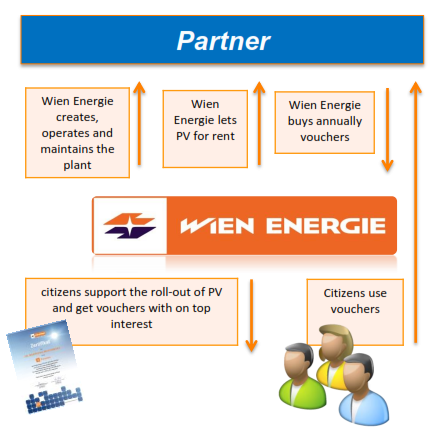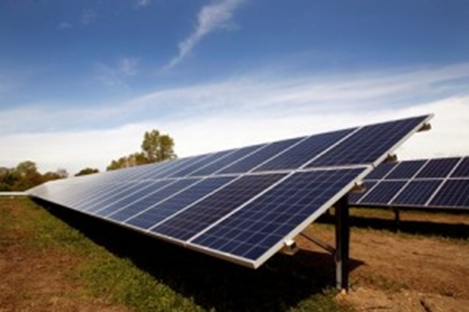Innovative financing instrument
References/sources
Project: Citizens’ Solar Power Plants: solar energy for everyone
Who needs to act?
Example: Citizens’ Solar Power Plant: Voucher-based

Who is affected?
It depends on the project; therefore, examples can be given only: all citizens can support the project, energy supplier, enterprises, etc.
Solution
Crowdfunding is a method of raising capital through the collective effort of friends, family, customers, and individual investors. This approach taps into the collective efforts of a large pool of individuals—primarily online via social media and crowdfunding platforms—and leverages their networks for greater reach and exposure
There are three general categories crowdfunding can fall under: Equity, Donation, and Debt.
Equity-based crowdfunding is asking a crowd to donate to your business or project in exchange for equity.
Donation-based crowdfunding is asking a crowd to donate to your project in exchange for tangible, non-monetary rewards such as an ecard, t-shirt, pre-released CD, or the finished product.
Debt-based crowdfunding is asking a crowd to donate to your business or business project in exchange for financial return and/or interest at a future date.
Investment

Image: Citizen’s solar power station Donaustadt
Example
By investing in community-funded solar power plants, Viennese citizens have the opportunity to participate in the development of renewable energies. Citizens’ Solar Power Plants mark the beginning of the dawn of a solar energy future for Vienna, and show the city’s clear commitment to developing solar energy.
The City of Vienna strongly supports photovoltaic energy production, which started into a new boom last year already.
On 4 May 2012, the first citizen solar power plant opened on the site of the Donaustadt power plant in the north of Vienna, with 2.100 photovoltaic modules and an output of 500 kilowatt peak (kWp). The energy is fed into the Vienna power grid and provides solar power for approximately 200 local households.
All solar panels of the first two Citizens’ Solar Power Plants (in Leopoldau and Donaustadt) were sold out within a single week. Now two more plants have been completed in the districts of Simmering and Liesing. Compared to conventional electricity production, harnessing the sun as an energy source saves around 800 tons of CO2 per year. The new Citizens’ Solar Power Plant in Simmering generates green electricity with over 2.000 panels covering a total area of approximately 3.200 m2.
Wien Energie, the city-owned energy provider of the Austrian capital Vienna, has set a target of increasing the share of renewable energy in total electricity production to 50 per cent by 2030. Green energy is produced close to consumers to minimise transmission losses and reduce dependency on electricity imports. This is the first time a participation model of this kind has been implemented in an urban area, and it has proven economical even without subsidising feed-in tariffs.
Return of investment
Shares in the Vienna Citizens’ Solar Power Plants can be acquired by any private individual living in Austria. The regional power supply company Wien Energie is in charge of building the turnkey photovoltaic systems and operating them. Citizens can buy whole or half panels at a price of EUR 950 or EUR 475 respectively. Wien Energie rents the panels from the individual purchasers, who then receive an annual profit of 3,1 per cent on their investment. The annual “rent” is paid directly to their accounts once a year. Once the service life of the plant ends after approximately 25 years, Wien Energie repurchases the panels, and the amount originally invested is returned to the citizens.
Other resources to be used
Country specific legal requirements must be taken into account.
Summary is in: Review of Crowdfunding Regulation Market Developments for RES project financing in the EU “Unleashing published the potential of Crowdfunding for Financing Renewable Energy Projects”, by: Osborne Clarke, Tanja Aschenbeck-Florange, Alexander Dlouhy, in December 2015
Available tools
Crowdfunding platforms in Austria:
- 1000x1000.at
- evercrowd.com
- fundraizer.at
- homerocket.com
- regionalfunding.at
- rendity.com
- respekt.net
Reward based Crowdfunding-platforms
- indiegogo.com
- kickstarter.com
- startnext.com
- wemakeit.com
Main steps of implementation
- Pick your project: A crowdfunding project needs to be specific. It must have a clear outcome and be time-limited.
- Write your budget: Your crowdfunding campaign needs a target so it's important you're clear about how much money you need and where it is going to go. Remember to include in your budget the commission you'll need to pay to the crowdfunding site and any costs incurred by honouring the rewards.
- Prepare your pitch: The most successful crowdfunding campaigns are the ones accompanied by a video explaining what the project is, what you want the money for and what the difference will be when you're successful.
- Pick your platform: A dedicated crowdfunding platform will take the pain out of managing financial contributions but there are already a lot to choose from.
- Plan your social media campaign: Putting your campaign onto a crowdfunding platform is only the first step. To help people find it and build a movement of support you need to make the most of your online presence.
- Keep in touch: It's important that you keep people updated about the progress of the campaign.
Expected results
Benefits of the crowdfunding models:
- Economical possibility to make solar energy usable in urban areas
- Completely riskless for citizens – carefree!
- Overcome legal and directive barriers of in rent living citizens
- Promotes ecological awareness of Viennese citizens and climate protection (get in touch with energy production)
- Supports quality of live in the hometown
- Enhancement of energy-independence
- Citizens create the energy revolution in hometown
- Local value added based on local partners and local energy production
- Formation of opinion benefits supports general PV roll-out
Contribution to SEAP & indicators
It depends on the implemented measure
How to integrate in SEAP?
Financing of measures
Contribution to SUMP & indicators
It depends on the implemented measure
How to integrate in SUMP?
Financing of measures
Lessons learned
Challenges:
- Financial Market Authority (securities prospectus requirement, banking practice law)
- Suitable Location had to be found within a few weeks (project partner quit): structural analysis, connection with the grid, power transformer, shadowing, ownership structure, etc.
- Regulatory approvals: many municipal authorities involved (electricity department, monument conservation, fire department, environment protection, department of building regulation, labor inspector, etc.)
- Time schedule (politics, call for bids, etc.)
Other information
The Austrian financial market authority is very carefully informing citizens about potential risks of this model and information about crowdfunding models is available at their website.
Funding Centre provides information on How to set up a crowdfunding project. The link provides a checklist on how to set a crowdfunding project including all main steps which have been taken for a successful project implementation.

